中秋节Mid-Autumn Festival英文版PPT
- 格式:ppt
- 大小:8.41 MB
- 文档页数:13
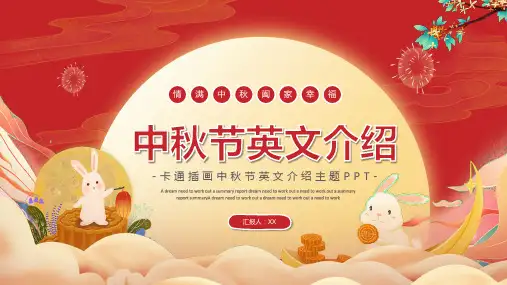
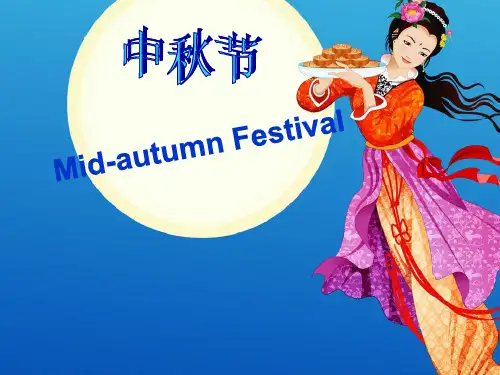
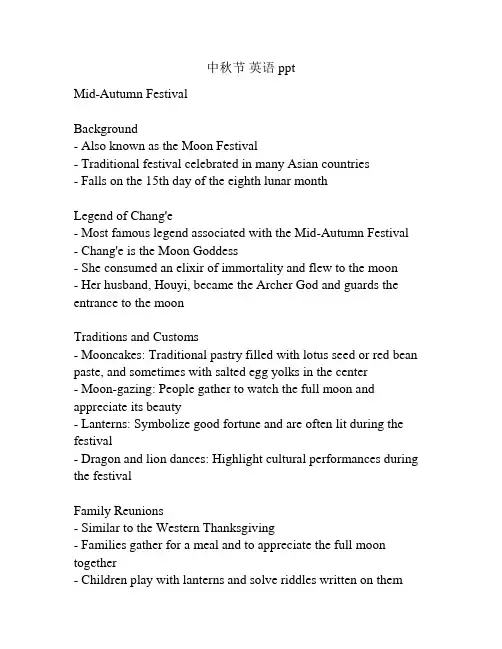
中秋节英语pptMid-Autumn FestivalBackground- Also known as the Moon Festival- Traditional festival celebrated in many Asian countries- Falls on the 15th day of the eighth lunar monthLegend of Chang'e- Most famous legend associated with the Mid-Autumn Festival - Chang'e is the Moon Goddess- She consumed an elixir of immortality and flew to the moon- Her husband, Houyi, became the Archer God and guards the entrance to the moonTraditions and Customs- Mooncakes: Traditional pastry filled with lotus seed or red bean paste, and sometimes with salted egg yolks in the center- Moon-gazing: People gather to watch the full moon and appreciate its beauty- Lanterns: Symbolize good fortune and are often lit during the festival- Dragon and lion dances: Highlight cultural performances during the festivalFamily Reunions- Similar to the Western Thanksgiving- Families gather for a meal and to appreciate the full moon together- Children play with lanterns and solve riddles written on themModern Celebrations- Apart from traditional customs, there are modern activities during the Mid-Autumn Festival- Fireworks, concerts, and other performances are held in some countries- The festival is a time for family and friends to come together and celebrateConclusion- The Mid-Autumn Festival is a time to celebrate family, appreciate the moon, and enjoy traditional customs- It is an important cultural event in many Asian countries。
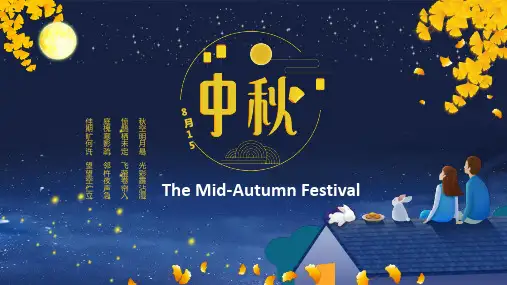
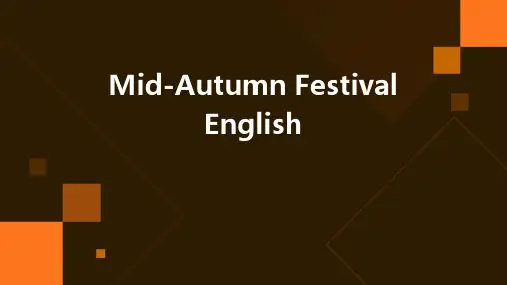
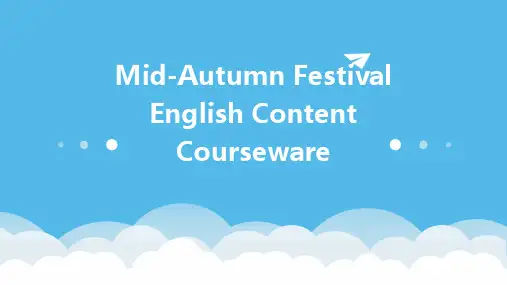
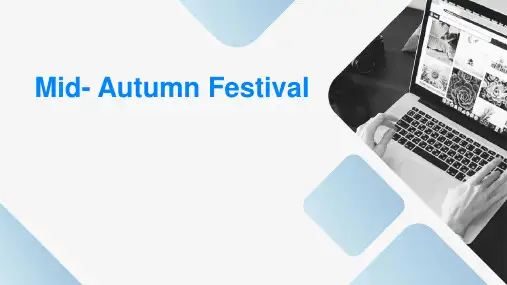
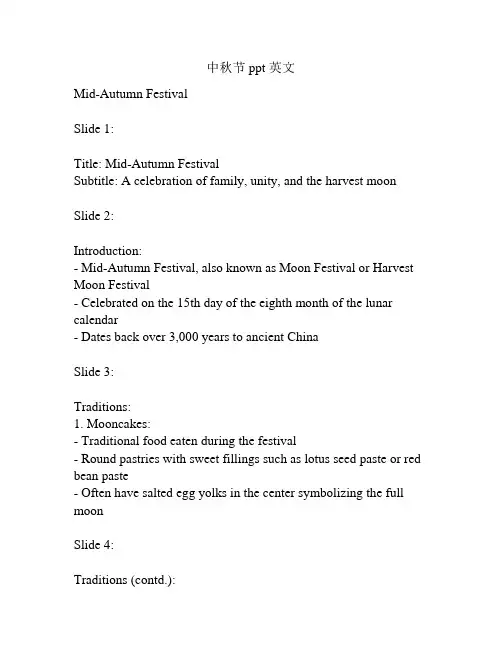
中秋节ppt 英文Mid-Autumn FestivalSlide 1:Title: Mid-Autumn FestivalSubtitle: A celebration of family, unity, and the harvest moon Slide 2:Introduction:- Mid-Autumn Festival, also known as Moon Festival or Harvest Moon Festival- Celebrated on the 15th day of the eighth month of the lunar calendar- Dates back over 3,000 years to ancient ChinaSlide 3:Traditions:1. Mooncakes:- Traditional food eaten during the festival- Round pastries with sweet fillings such as lotus seed paste or red bean paste- Often have salted egg yolks in the center symbolizing the full moonSlide 4:Traditions (contd.):2. Lanterns:- Lighting and displaying colorful lanterns is a common tradition - Lanterns can be shaped like animals, fruits, or traditional symbols - Symbolize brightness, good luck, and driving away evil spiritsSlide 5:Traditions (contd.):3. Paper Fans and Dragon Dancing:- People often perform dragon dances on the streets- Paper fans are used to create rhythmic sounds during the dance - Symbolize chasing away evil spirits and bringing good fortune Slide 6:Family Reunion:- Mid-Autumn Festival is a time for family reunions- Family members gather to enjoy mooncakes, tea, and appreciate the moon together- Often an occasion for storytelling and sharing legends and mythsSlide 7:The Legend of Chang'e:- Most popular legend associated with the Mid-Autumn Festival- Tells the story of Chang'e, a beautiful woman who flew to the moon- Her husband, Houyi, is left on Earth, longing for herSlide 8:The Legend of Chang'e (contd.):- People place offerings on altars and make wishes to Chang'e- Believed that on this day, the moon is closest to Earth, making the wishes more likely to come true- Symbolizes hope, reunion, and loveSlide 9:Conclusion:- Mid-Autumn Festival is a time for celebration, family, and unity - A chance to appreciate the harvest moon and make wishes for the future- A significant cultural event celebrated by Chinese communities worldwideSlide 10:Thank you!- Questions?。
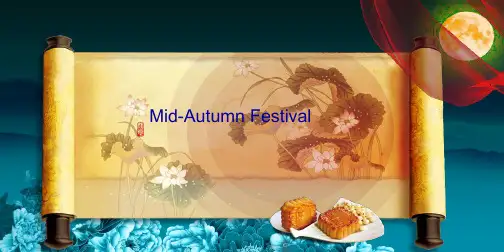
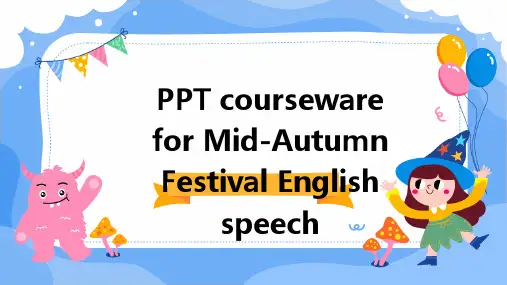
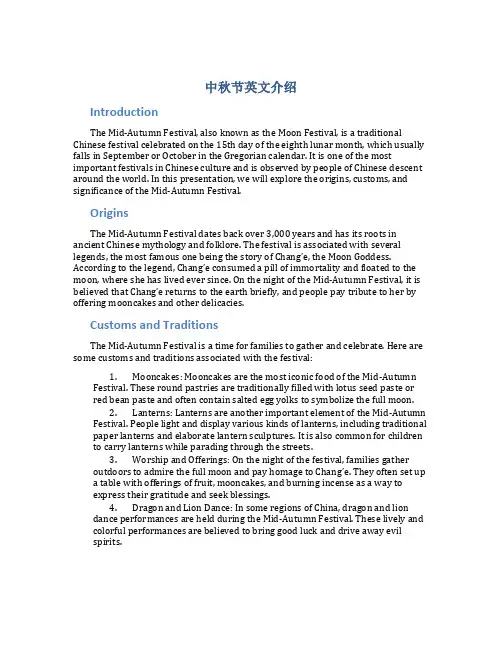
中秋节英文介绍IntroductionThe Mid-Autumn Festival, also known as the Moon Festival, is a traditional Chinese festival celebrated on the 15th day of the eighth lunar month, which usually falls in September or October in the Gregorian calendar. It is one of the most important festivals in Chinese culture and is observed by people of Chinese descent around the world. In this presentation, we will explore the origins, customs, and significance of the Mid-Autumn Festival.OriginsThe Mid-Autumn Festival dates back over 3,000 years and has its roots in ancient Chinese mythology and folklore. The festival is associated with several legends, the most famous one being the story of Chang’e, the Moon Goddess. According to the legend, Chang’e consumed a pill of immortality and floated to the moon, where she has lived ever since. On the night of the Mid-Autumn Festival, it is believed that Chang’e returns to the earth briefly, and people pay tribute to her by offering mooncakes and other delicacies.Customs and TraditionsThe Mid-Autumn Festival is a time for families to gather and celebrate. Here are some customs and traditions associated with the festival:1.Mooncakes: Mooncakes are the most iconic food of the Mid-AutumnFestival. These round pastries are traditionally filled with lotus seed paste or red bean paste and often contain salted egg yolks to symbolize the full moon.nterns: Lanterns are another important element of the Mid-AutumnFestival. People light and display various kinds of lanterns, including traditional paper lanterns and elaborate lantern sculptures. It is also common for children to carry lanterns while parading through the streets.3.Worship and Offerings: On the night of the festival, families gatheroutdoors to admire the full moon and pay homage to Chang’e. They often set upa table with offerings of fruit, mooncakes, and burning incense as a way toexpress their gratitude and seek blessings.4.Dragon and Lion Dance: In some regions of China, dragon and liondance performances are held during the Mid-Autumn Festival. These lively and colorful performances are believed to bring good luck and drive away evilspirits.SignificanceThe Mid-Autumn Festival holds great cultural and emotional significance for the Chinese people. Here are a few reasons why the festival is so important:1.Family Reunion: The Mid-Autumn Festival is often referred to as a。
中秋节英文pptMid-Autumn Festival中秋节是中国传统的一个重要节日,通常在每年农历八月十五日庆祝。
人们会在这一天欢聚一堂,赏月,吃月饼,传统的活动也包括赏月灯和嫦娥奔月的传说故事。
The Mid-Autumn Festival is an important traditional Chinese holiday, usually celebrated on the 15th day of the eighth lunar month. On this day, people gather together to enjoy the moon, eat mooncakes, and participate in traditional activities such as viewing lanterns and hearing the legend of Chang'e, the moon goddess.传统食物Traditional Food中秋节最有名的食物就是月饼。
月饼是一种圆形的糕点,里面通常包含着各种馅料,如莲蓉、红豆沙以及五仁等。
除了月饼,人们还喜欢品尝一些代表丰收的水果和糖果。
The most famous food during the Mid-Autumn Festival is mooncakes. Mooncakes are round pastries with various fillings such as lotus seed paste, red bean paste, and mixed nuts. In addition to mooncakes, people also enjoy indulging in fruits and candies that symbolize a fruitful harvest.文化传承Cultural Heritage中秋节是中国传统文化的一部分,人们通过庆祝这个节日来传承和弘扬中华文化。
中秋节英语介绍pptTitle: The Mid-Autumn FestivalSlide 1:- Title: The Mid-Autumn Festival- Background with a full moonSlide 2:- Introduction: What is the Mid-Autumn Festival?- Brief explanation of the festival's origins and significance- Festivals in China are often related to lunar cyclesSlide 3:- Date and Timing of the Festival- Occurs on the 15th day of the 8th month in the lunar calendar - Falls on a different day each year in the Gregorian calendar Slide 4:- Legends and Stories:- The story of Chang'e (Goddess of the Moon)- Houyi and the Ten SunsSlide 5:- Customs and Traditions:- Mooncakes: Traditional Chinese delicacies filled with various sweet or savory fillings- Lanterns: Lighting lanterns to create a festive atmosphere Slide 6:- Family Reunions:- Mid-Autumn Festival is a time for family reunions- Families gather for a feast and enjoy mooncakes together Slide 7:- Moon Gazing:- People go outside to admire the full moon during the festival - Symbolizes unity and completenessSlide 8:- Activities and Celebrations:- Dragon and lion dances- Lantern parades- Fireworks displaysSlide 9:- Conclusion: Importance of the Mid-Autumn Festival- Promotes family bonds and unity- Showcases Chinese culture and traditions- Celebration of harvest and gratitudeSlide 10:- Thank You!- Questions and AnswersSlide 11:- References:- List of sources used for research。